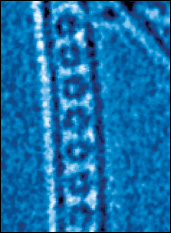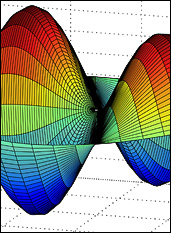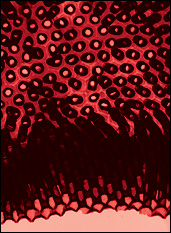Saving Silver: MSE Professor Raymond Phaneuf's research group, in collaboration with conservators at the Walters Art Museum in Baltimore have developed atoms-thick coatings designed to protect silver artifacts from tarnish and corrosion longer and more effectively than nitrocellulose lacquers. More...
 Volumes So Small, a Drop of Water is a Lake: Members of the undergraduate Class of 2008 studied the behavior of fluids at the nanoliter level, and proposed a "micro-mixer" design that could enhance the performance of lab technologies used in chemical engineering, biology, bioengineering, DNA analysis, and pharmacology. More...
Volumes So Small, a Drop of Water is a Lake: Members of the undergraduate Class of 2008 studied the behavior of fluids at the nanoliter level, and proposed a "micro-mixer" design that could enhance the performance of lab technologies used in chemical engineering, biology, bioengineering, DNA analysis, and pharmacology. More...
 Tiny, Threat-Detecting Lasers: MSE Professor Aris Christou "grows" lasers at the mico- and nano-scale that are used as sensors detect biological threats. More...
Tiny, Threat-Detecting Lasers: MSE Professor Aris Christou "grows" lasers at the mico- and nano-scale that are used as sensors detect biological threats. More...
 How Do You Test a Device You Can't See? MSE Professor John Cumings and his research group have developed a new electron microscopy technique that will allow scientists to test nanoscale devices in real-time while they are observed in a transmission electron microscope. More...
How Do You Test a Device You Can't See? MSE Professor John Cumings and his research group have developed a new electron microscopy technique that will allow scientists to test nanoscale devices in real-time while they are observed in a transmission electron microscope. More...
 "Growing" Computer Components: MSE Professor Raymond Phaneuf has developed a template nature can follow to produce "self-assembling" structures. The template causes atoms to be arranged in a defined pattern that can serve a variety of purposes—a semiconductor in a laptop, a component in a cell phone or a sensor in a wearable device. More...
"Growing" Computer Components: MSE Professor Raymond Phaneuf has developed a template nature can follow to produce "self-assembling" structures. The template causes atoms to be arranged in a defined pattern that can serve a variety of purposes—a semiconductor in a laptop, a component in a cell phone or a sensor in a wearable device. More...
 Positioning Nanoparticles Where You Need Them: Professor Oded Rabin and his graduate student have developed techniques to position silver nanocubes in predetermined locations on a substrate (surface). These techniques are needed to study interactions between neighboring particles. In recent work the group succeeded to show that pairs of silver nanocubes, positioned face-to-face or edge-to-face, are very effective as chemical sensors utilizing a phenomena called Raman scattering. More...
Positioning Nanoparticles Where You Need Them: Professor Oded Rabin and his graduate student have developed techniques to position silver nanocubes in predetermined locations on a substrate (surface). These techniques are needed to study interactions between neighboring particles. In recent work the group succeeded to show that pairs of silver nanocubes, positioned face-to-face or edge-to-face, are very effective as chemical sensors utilizing a phenomena called Raman scattering. More...



